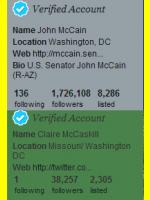
Five Ways Twitter Can Adapt Itself for Government

Twitter is set to hire its first employee in Washington, DC, a Government Liaison. That’s great news.
Here’s even better news for Twitter: you don’t have to sell your product to representatives. They know it’s useful. They look at John McCain and Chuck Grassley. They look at Barack Obama. What elected representative doesn’t want 40 thousand, or a million, or four million people instantly notified of their legislative victories, or what they’re reading (McCain: Cosby’s Quiet Hero) or where they’re eating dinner (Grassley: Drake’s Diner).
But treating twitter as just another broadcast medium is missing the point, and I hope the company’s new employee makes that case until everyone hears. Here’s the message in 140 characters:
Twitter is good to talk to people; better to listen! Research constituents’ hashtags; respond to direct messages. ENGAGE don’t pontificate!
And here’s the rub: Twitter can verify John McCain, but they can’t verify his one million followers. About two weeks ago, I was talking about Twitter with Tim Hysom of the Congressional Management Foundation. He said that while a lot of congressional representatives use Twitter (he cited Claire McCaskill specifically), he told me that the biggest barrier to elected officials fully embracing Twitter was that anyone could change their profile to make it look like they were a constituent.
I’d like to be the first to say to Twitter’s new employee: welcome to the party, but don’t get comfortable. Here are five things I’d like to see Twitter do to make itself more useful to government, and more useful to citizens:
- Address/ID Verification. I don’t know exactly how this could work; perhaps something tied to voter registration?
- Allow pictures instead of text as tweets (though, we’ll have to be satisfied with 14 percent of each picture, given the oft-cited picture:word ratio.)
- Set up a tiered system for posting tweets, so followers get tweets first, everyone else second to incentivize followership and alert constituents first, the rest of the world second.
- A strong statistics package: let officials see, for example, all replies to a specific post on a single page, enumerated, and with an analysis of the post by hashtag, first word, or some other variable
- District-wide (rather than just ZIP-code or city-based) trends.
And that’s just what I can come up with for starters. Like Gov 2.0 itself, adapting Twitter for government will be a collaborative process. Let the innovation begin!



